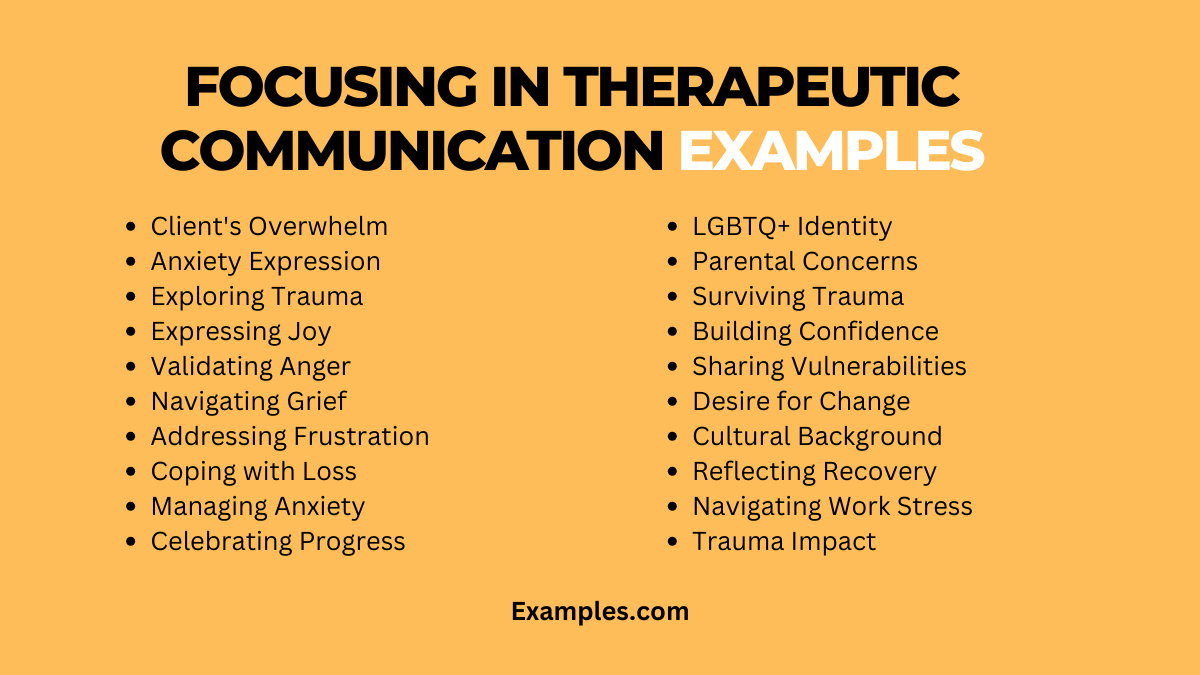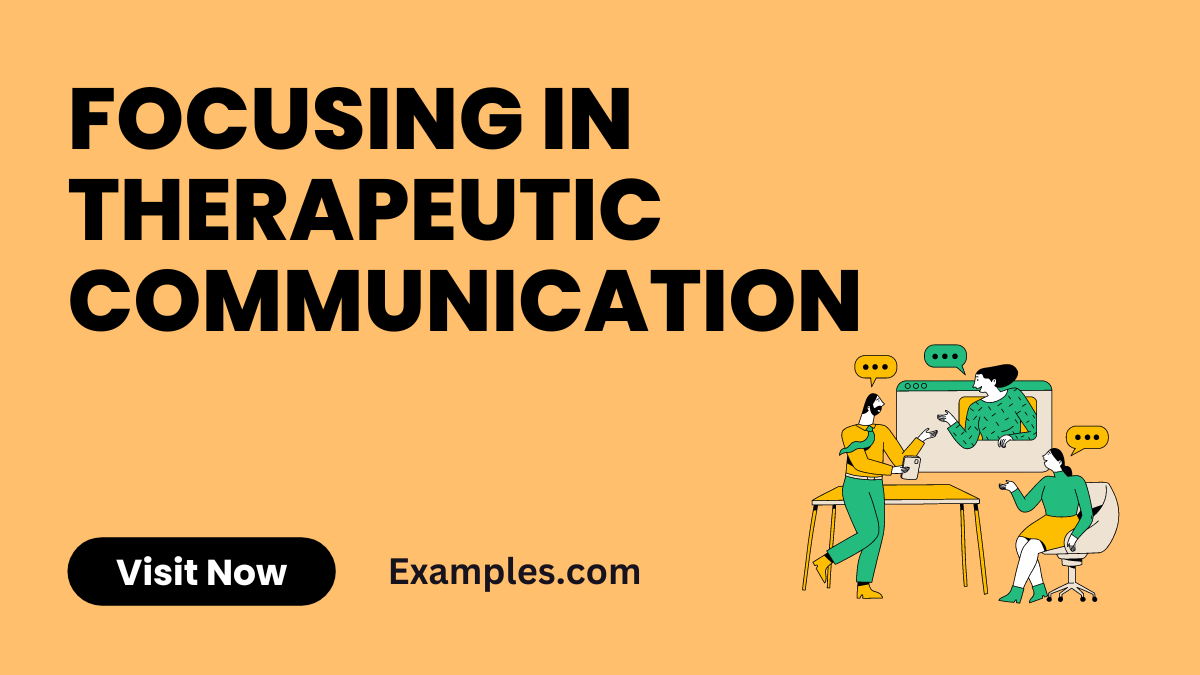Focusing in Therapeutic Communication
Dive into the comprehensive guide on Focusing in Therapeutic Communication, where precision meets empathy. Explore proven techniques and strategies with vivid Communication Examples, guiding you to create meaningful connections. Elevate your therapeutic interactions by mastering the art of focus, fostering deeper understanding, and enhancing the impact of your communication skills.
What is Focusing in Therapeutic Communication?

Focusing in Therapeutic Communication is the intentional concentration on a client’s thoughts, emotions, or experiences during a therapeutic encounter. It involves creating a mental and emotional space to fully comprehend and respond to the client’s needs, fostering a deeper connection and understanding. This technique helps the therapist tune in to the client’s unique perspective, enhancing the therapeutic relationship and facilitating more effective communication.
20 Focusing in Therapeutic Communication Examples

Enhancing therapeutic connection, focusing involves attentive concentration on a client’s expressed thoughts or emotions. By directing attention purposefully, therapists create a supportive space for clients to explore their experiences. This method encourages deeper understanding and promotes effective communication within therapeutic relationships.
- Client’s Overwhelm: Therapist focuses on the client’s overwhelmed feelings, allowing exploration of contributing factors.
- Anxiety Expression: Acknowledging anxiety, the therapist focuses on strategies to manage and understand its roots.
- Exploring Trauma: Focusing on a client’s trauma, the therapist supports gradual exploration, ensuring a safe space.
- Expressing Joy: Acknowledging joy, the therapist focuses on activities fostering happiness for the client.
- Validating Anger: Focusing on anger, the therapist validates the emotion, channeling it constructively.
- Navigating Grief: The therapist focuses on grief, creating space for the client to share and process.
- Addressing Frustration: Focused on frustration, the therapist explores school-related stressors with the teen.
- Coping with Loss: Therapist focuses on coping mechanisms when a client shares experiences of loss.
- Managing Anxiety: Focusing on anxiety, the therapist collaborates on effective coping strategies.
- Celebrating Progress: Therapist focuses on acknowledging progress, reflecting on the client’s journey.
- LGBTQ+ Identity: Focusing on LGBTQ+ identity, the therapist fosters a supportive and accepting space.
- Parental Concerns: Acknowledging parental concerns, the therapist addresses challenges and strategies.
- Surviving Trauma: Focusing on survival, the therapist helps navigate triggers and promote healing.
- Building Confidence: The therapist focuses on self-doubt, exploring strengths and building confidence.
- Sharing Vulnerabilities: Focusing on vulnerabilities, the therapist appreciates the courage in sharing.
- Desire for Change: Acknowledging the need for change, the therapist collaborates on goal setting.
- Cultural Background: Focusing on cultural differences, the therapist incorporates cultural sensitivity.
- Reflecting Recovery: The therapist focuses on recovery milestones, highlighting strengths and progress.
- Navigating Work Stress: Focusing on work stress, the therapist explores strategies for professional well-being.
- Trauma Impact: Focusing on trauma, the therapist validates its impact, working towards healing.
Focusing in Therapeutic Communication Examples in Nursing
In nursing, focusing plays a pivotal role in patient care. It involves directing attention to patients’ concerns, emotions, and health challenges. This approach enhances empathetic understanding, creating a foundation for effective communication between nurses and patients, ultimately contributing to holistic care and well-being.
- Patient’s Pain Management: Nurses focus on a patient’s pain experience, tailoring interventions for effective pain management.
- Addressing Anxiety: Focusing on a patient’s anxiety, nurses employ calming techniques and communication to alleviate distress.
- Supporting Grieving Families: Nurses concentrate on supporting grieving families, offering empathetic presence and resources.
- Medication Understanding: Focusing on medication concerns, nurses ensure patients comprehend and adhere to prescribed regimens.
- Encouraging Emotional Expression: Nurses focus on creating an environment for patients to express emotions freely, fostering emotional well-being.
- Managing Chronic Conditions: Focusing on chronic conditions, nurses collaborate on strategies for daily management and coping.
- Childhood Illness Communication: Nurses focus on clear communication with children, ensuring understanding and comfort during illness.
- Patient Education on Procedures: Focusing on procedural concerns, nurses educate patients, alleviating anxieties related to medical procedures.
- Promoting Mental Health: Nurses concentrate on mental health discussions, facilitating conversations to destigmatize and support well-being.
- Holistic Health Assessment: Focusing on holistic health, nurses engage patients in comprehensive assessments, addressing physical and emotional aspects.
Focusing in Therapeutic Communication Examples in Healthcare
In broader healthcare contexts, focusing within therapeutic communication is vital for effective interactions among healthcare professionals, patients, and their families. This approach enhances understanding, fosters trust, and contributes to a collaborative and patient-centered healthcare environment.
- Interdisciplinary Team Communication: In healthcare settings, focusing involves precise communication among diverse healthcare professionals to ensure cohesive patient care.
- End-of-Life Discussions: Focusing on end-of-life care, healthcare providers concentrate on facilitating open and compassionate discussions with patients and families.
- Patient-Centered Decision-Making: Focusing on shared decision-making, healthcare professionals engage patients in discussions about treatment plans, respecting individual preferences.
- Effective Handovers: Focusing during shift handovers ensures accurate and comprehensive information exchange, promoting continuity of care.
- Informed Consent Conversations: Healthcare providers focus on explaining procedures, risks, and benefits, facilitating informed consent discussions with patients.
- Crisis Intervention: During crises, focusing involves clear communication to manage situations effectively and provide emotional support to patients and families.
- Patient Education Programs: Focusing on educational initiatives, healthcare professionals tailor information to patients’ needs, ensuring better understanding and compliance.
- Health Promotion Conversations: Focusing on preventive care, healthcare providers engage in conversations that empower patients to adopt healthier lifestyles.
- Remote Telehealth Interactions: In virtual healthcare, focusing on clear communication is crucial for effective telehealth consultations, ensuring patient understanding and engagement.
- Navigating Cultural Sensitivity: Focusing on cultural competence in healthcare conversations helps healthcare professionals understand and respect diverse cultural perspectives, enhancing patient-centered care.
What is the Concept of Focusing in Therapeutic Communication?
Focusing in therapeutic communication is a dynamic process that involves directing attention and concentration towards a specific aspect of a patient’s experience or expression. It revolves around creating a focal point, allowing both the practitioner and the individual in therapy to delve deeper into emotions, concerns, or specific issues. This concept emphasizes active listening, empathy, and a purposeful narrowing of focus to enhance the therapeutic relationship and facilitate meaningful dialogue.
What are the Roles of Focusing in Therapeutic Communication?

- Enhancing Empathetic Understanding: Focusing plays a pivotal role in deepening empathetic understanding between the practitioner and the individual in therapy. By honing in on specific thoughts or emotions, practitioners demonstrate a keen awareness of the patient’s inner experiences, fostering a sense of being truly heard and understood.
- Facilitating Effective Communication: The concept of focusing acts as a facilitator for effective communication. It provides a structured approach, guiding both parties to explore and articulate thoughts and emotions with clarity. This, in turn, reduces miscommunication and enhances the overall therapeutic process.
- Building Trust and Rapport: Focusing contributes significantly to building trust and rapport within the therapeutic relationship. By concentrating on the individual’s unique experiences, practitioners create an environment where patients feel safe to express themselves openly, fostering a foundation of trust essential for therapeutic success.
- Promoting Holistic Exploration: Focusing in therapeutic communication encourages a holistic exploration of an individual’s experiences. It goes beyond surface-level conversations, allowing both the practitioner and patient to delve into multifaceted aspects of emotions, behaviors, and underlying issues, promoting a comprehensive understanding.
How Focusing in Therapeutic Communication is Helpful?
- Deepening Insight into Patient’s Concerns: Focusing serves as a powerful tool for deepening insight into the patient’s concerns. It allows practitioners to hone in on specific issues, enabling a more profound understanding of the patient’s emotional landscape and contributing factors.
- Tailoring Therapeutic Interventions: By focusing on particular aspects of the patient’s experience, practitioners can tailor therapeutic interventions more precisely. This customization enhances the effectiveness of therapeutic strategies, addressing specific needs and fostering positive outcomes.
- Eliciting Patient Reflection and Awareness: Focusing prompts patients to reflect on their experiences and gain self-awareness. This introspection is crucial for personal growth and therapeutic progress, as individuals become more attuned to their thoughts and emotions in the context of the therapeutic relationship.
- Empowering Patients in Decision-Making: Focusing empowers patients in the therapeutic process by involving them in decision-making. When individuals feel their concerns are being focused on, they become active participants in their own healing journey, contributing to a sense of autonomy and control.
In conclusion, mastering the art of focusing in therapeutic communication is pivotal for fostering genuine connections and meaningful dialogues. By honing in on specific aspects of a patient’s experience, practitioners deepen empathy, build trust, and tailor interventions. This comprehensive guide, accompanied by real-world examples, equips professionals with the tools to enhance the therapeutic process, creating a path towards transformative healing and positive outcomes.



